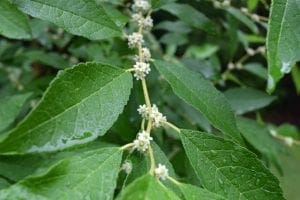

Scientific name: Ilex verticillata
Common name: Winterberry
Family: Aquifoliaceae
Plant type: Shrub
Ilex verticillata provides excellent winter interest in the garden thanks to a profusion of bright red berries that persist throughout the cold season; hence the common name winterberry. Birds love the berries and use them as a winter food source. In the wild, winterberry is typically found as a 6-10’ multi-trunked shrub, but plants can occasionally grow to 25’ tall. The species has a rounded growth habit, and often grows as wide as it is tall. Deciduous leaves are alternate and 1.5-3” long. Their shape is approximately elliptical with pointed tips, sharply toothed edges, and pronounced veins. Winterberry is dioecious (separate male and female plants), with tiny white spring flowers. Male flowers appear in clusters, but female flowers are either single, or in small groups of no more than 3 blossoms. Only female plants produce berries, and that can happen only if there is male nearby (within about 50’) to pollinate the female flowers. Winterberry can handle flooding and can be found in wetlands and swamps, as well along forest edges. It tolerates some salt, but not drought, and prefers acidic soils. Winterberry is a very versatile species. Like other members of the holly family, it makes a good hedge plant, provides year-long decoration at the rear of an herbaceous border, and can be used in foundation plantings. In addition, it is an excellent choice for rain gardens.
Credtis: Text by Valerie Boss. Photos by Ellen Honeycutt.
